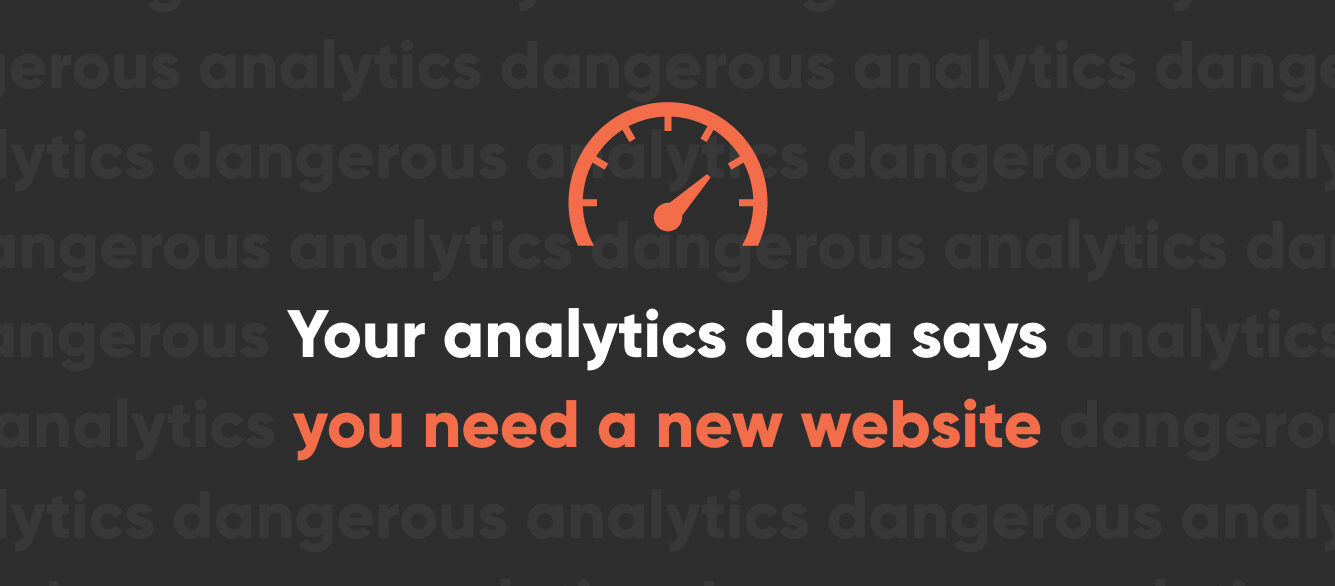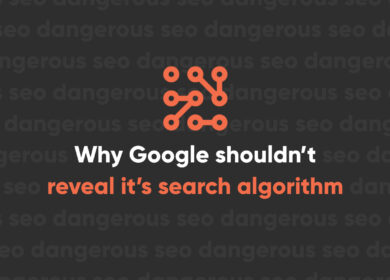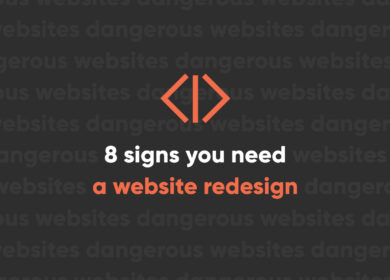
Your Analytics Data Says You Need a New Website

Many business owners take a rather subjective approach to determine when they need a new website. They may look at their own site and think it looks outdated. Or they might look at a competitor’s brand new site and get the sudden urge to do better. Or they may shrug and say, “Looks fine to me. We don’t need a new website.” Whatever the method, the driving force behind the decision is often based on a brief thought or feeling.
This isn’t necessarily a bad way of doing it. After all, if you think you need a new website, then you probably need a new website.
But what about those cases where you don’t think you need a new site and you really do? You might have several people telling you it’s time to redesign. Or you might be seeing a big uptick in spam emails offering you a great redesign package. However, no matter how many people insist a new website will benefit you, you continue to believe in your current site.
This is when you need to turn to your data. Your analytics data, that is.
Your analytics data contains an entire story of your site. It has all the facts, and it can even tell you if you need a new website. In some cases, your analytics is probably screaming at you to get a new site now.
Here’s where you need to look to see what the data is trying to tell you:
Look at your Conversions
Conversions are probably the most important metric for your website. Whether your site is e-commerce or lead generation, you need it to convert. If you’re not making sales or getting leads, then something is obviously amiss.
The design and functionality of your website can have a big impact on your conversions. Your visitors are more likely to trust you and become customers if you have an updated and modern design. Nothing makes potential customers run away faster than an old website that doesn’t function like it should.
So how can you tell if your conversion data is telling you it’s time for a new site? These are the most telling factors:
- You’re experiencing a decrease in conversions even though traffic is staying relatively consistent
- Your conversions aren’t going up even though you’re getting more traffic
- Your conversions have flatlined and you have a high abandonment rate

Looking at this year-over-year conversion funnel, there’s an obvious problem. Visits were up by 375%. Fantastic. Those new marketing efforts were really working. Contact page views were up by 414%. Great. You were getting people to your site who were actually interested in your service. But conversions stayed pretty much the same? Ouch. Something seems to be wrong here. Very wrong.
Of course, the numbers themselves don’t tell you everything. You have to consider other factors, such as your marketing efforts and any special offers. If you had a 50%-off sale last year, you can’t look at this year’s numbers and say a decrease in orders must mean you need a new website. The data is part of the story, not the whole thing. You often have to fill in the gaps to make the data meaningful.
A new website can’t guarantee more conversions. If you have a lousy product or undesired service, it may not matter what your site looks like. But if you believe in your product or service and your visitors aren’t converting, then the answer to the problem may very well lie in a brand new design.
Look at your Bounce Rate
Bounce rate is a tricky metric. Just looking at the percentage of users who are bouncing may not tell you much. After all, a visitor can accomplish everything they need to on your site and still register as a bounce. Maybe they just needed to find your address. Or maybe they read your great blog post and had all their questions answered. Not every visitor will convert.
But that doesn’t mean bounce rate isn’t telling you a story. Here are a few different things your bounce rate might be telling you about the need for a new site:
- Your bounce rate is going up because your website looks dated
- Your bounce rate is going up on specific devices because your site’s technology is outdated
- Your bounce rate is going up because your site isn’t functioning as well as other sites

Naturally, your bounce rate could be telling you other things. Maybe your content is bad. Or maybe the site simply doesn’t meet your user’s expectations. If your bounce rate has always been high, maybe it isn’t your website (or maybe it’s been that your design has been bad all along). However, if your bounce rate keeps going up, then your data is telling you it’s probably time for a new site.
Look at your Mobile Traffic
We’re probably all pretty sick of hearing that we’ve entered the age of mobile. More mobile searches than desktop searches. More people using mobile to shop than ever before. CEOs using mobile devices to research big business decisions. Blah, blah, blah.
Your analytics data is also telling you a mobile story. No matter what industry you’re in, your mobile traffic should be going up. Your mobile conversions should also be going up.
If people aren’t accessing your site from mobile devices, it doesn’t mean you are one of those rare industries where no one uses mobile. It means you are missing out on the increasing opportunity to reach customers on mobile.
Your mobile traffic data over the past few years should look a little something like this:

It’s not at all unusual to see mobile traffic that has doubled, tripled, or even quadrupled in the past two years. This tells you that more people are accessing your site on mobile. But it also provides insight into how well your site is working on mobile. Your mobile traffic isn’t just going up because more people are using mobile devices. It’s also going up because more people are able to find your site using mobile devices.
If your mobile traffic looks more like this, it should be sending a message that your site isn’t good enough to attract mobile customers.

Sure, maybe it’s just coincidence that your mobile traffic has gone down since Google’s mobile update. Or maybe your non-responsive website can’t gain any leverage with mobile visitors and is costing you thousands of dollars per month.
Don’t let your gut tell you your website is just fine. Listen to the data. It’s probably screaming for you to redesign that old website now.

Nate Tower
Nate Tower is the President of Perrill and has over 12 years of marketing and sales experience. During his career in digital marketing, Nate has demonstrated exceptional skills in strategic planning, creative ideation and execution. Nate's academic background includes a B.A. with a double major in English Language and Literature, Secondary Education, and a minor in Creative Writing from Washington University. He further expanded his expertise by completing the MBA Essentials program at Carlson Executive Education, University of Minnesota.
Nate holds multiple certifications from HubSpot and Google including Sales Hub Enterprise Implementation, Google Analytics for Power Users and Google Analytics 4. His unique blend of creative and analytical skills positions him as a leader in both the marketing and creative worlds. This, coupled with his passion for learning and educating, lends him the ability to make the complex accessible and the perplexing clear.
Join Our Newsletter


Why Google Shouldn’t Reveal Its Search Algorithm


8 Signs You Need a Website Redesign


